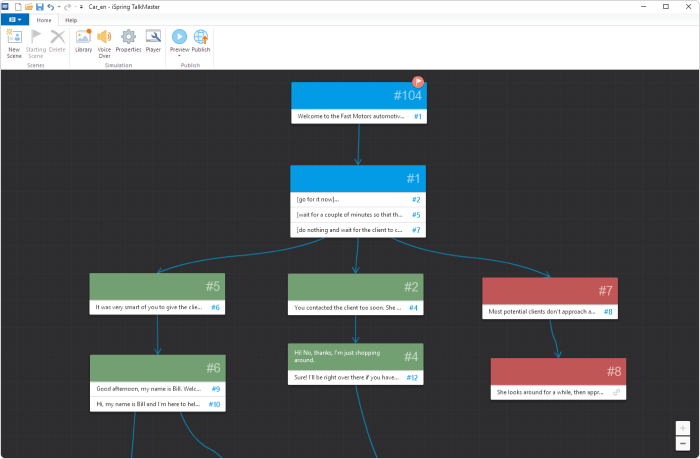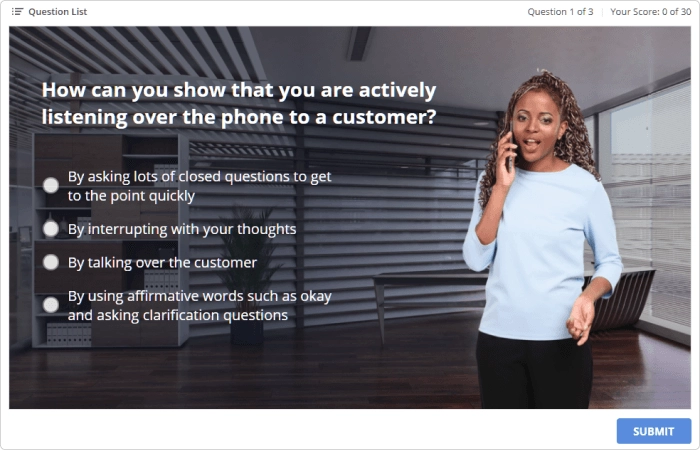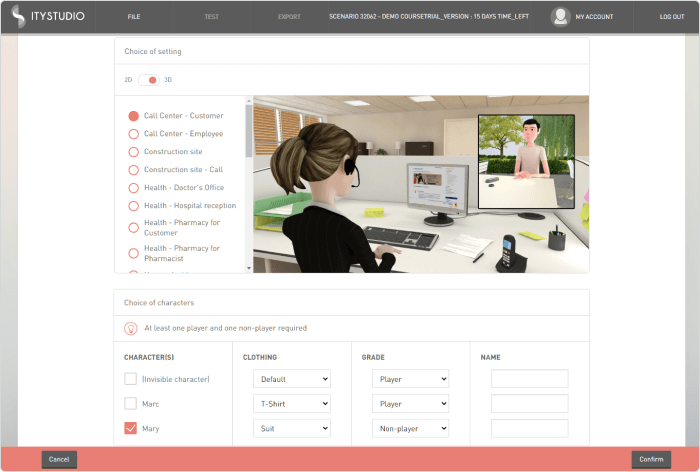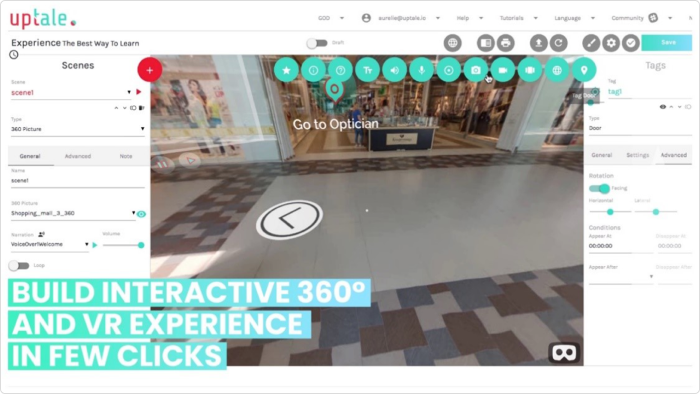6 Customer Service Training Tools for Every Occasion and Purpose

Every company offers more than its products. Whether it’s a piece of software or clothing, there’s also customer service behind it. And behind all customer service are people who should know how to build strong relationships with clients, handle complaints quickly, and respond to their issues on time. Good customer service doesn’t just happen overnight. If you want to keep clients coming back, you need to provide employees with consistent training.
You can make training quick and easy by using specific software tools. For example, offer your customer service agents to take courses on your company products and then check their knowledge with online quizzes. Or use dialog simulations to enable your team members to master their communication and problem-solving skills.
In this post, we’ll cover the top six customer service training tools that will help you turn new hires and even seasoned pros into product knowledge and communication experts. Let’s dive right in.
1. iSpring Suite: An All-in-One eLearning Development Solution

At the top of our list is a full-featured content authoring solution that can cover all your training needs – iSpring Suite. It takes a modularized approach and allows you to create different kinds of eLearning content. Here’s how you can contribute to customer service training with iSpring.
Provide new knowledge with slide-based courses
iSpring Suite integrates right in PowerPoint, which makes for a familiar interface that’s easy to use. You can turn existing PPT training materials into interactive courses or build courses on new products or services from scratch in a matter of minutes.
Here you can see a fragment from a product knowledge course on Marshall headphones created with iSpring:
Educate your customer service agents with training videos
iSpring Suite has a built-in video studio that allows you to record on-screen content and webcam footage. For instance, you can film a seasoned employee to demonstrate to your newly hired customer agents how to deal with customers in different situations. Or, you can record a training video with valuable tips on how to behave with a client.
After a video has been recorded, you can easily edit it: delete unwanted fragments, remove noise, insert captions and annotations, and add transition effects to make it look even more professional.
Train your team members’ soft skills with dialog simulations
These types of sims mimic real-life conversations with customers and let employees practice their reactions and responses in a safe environment. They learn by choosing what to say to an interlocutor in a particular situation and then receiving feedback based on their choice.
You can choose to set up various situations, such as a phone call from a bank client, a face-to-face conversation between a sales manager and a customer, or even a support chat or correspondence. The characters can check employees’ product knowledge, ask them complex questions to see if they understand or misread the problem, and even get irritated to test employees’ patience in a challenging situation.
With iSpring Suite, you can arrange all the scenes in a tree structure that makes even the most complex branching scenarios clear and allows you to manipulate them with a single click.

The software has a content library that contains a ready-made collection of characters with different poses and emotions, as well as a location gallery. You can choose the appropriate assets for your sim to make it even more realistic.

You can also upload your own images, such as photos of supervisors who work in your company and familiar environments.
Here’s what a conversation simulation created with iSpring looks like:
Check your employees’ knowledge with interactive quizzes
Effective assessment will make both you and your employees aware of current knowledge gaps. Tests can help you monitor employees’ progress and measure training outcomes.
iSpring Suite lets you choose from 14 types of questions, such as matching, fill-in-the-blanks, and drag-and-drops. Apart from the questions themselves, you can add information slides and feedback messages that will vary depending on the answers your learners give. These can include images, graphs, formulas, audio, video, and other relevant content. The QuizMaker tool provides flexible grading options, including choosing a passing score and the number of attempts allowed.
When talking by phone or communicating in a live chat, customer service professionals need to act quickly. To see how well prepared a learner
is, you can try setting a time limit per specific question or for the entire test.
Here is a slide from the customer service quiz created with iSpring:

Pricing: $970/year. It includes the iSpring Suite authoring toolkit, access to Content Library, iSpring Cloud (online storage for review and collaboration), live priority support via phone and chat, and all updates.
2. Branch Track: An Authoring Tool for Conversation Simulations

Branch Track is another tool for creating scenario-based training. The way it works and looks is very similar to that of the iSpring dialog simulation tool. It has a drag-and-drop editor that makes it easy to design a scenario tree and connect and move scenes, and built-in galleries of environments and characters presented in different poses and emotions.
As you can see, it’s a very intuitive tool and doesn’t require any tech skills – just like iSpring. However, unlike iSpring, Branch Track is a cloud-based solution, so all the simulations are created online in a browser. This is a good thing if you work on course development together with your colleagues and want to get instant feedback from them. You don’t need to send scripts and test files back and forth. You can simply deliver a course link to your SMEs and stakeholders and collect their feedback online.
Pricing: It’s a very pricey solution. For example, a Professional plan costs $999 per year and allows you to create only 10 scenarios. The Corporate plan, which includes 50 scenarios, costs $3,999 per year. Compare this to the full-featured iSpring authoring toolkit that costs only $970 per year and allows you to build an unlimited number of dialog simulations, courses, and quizzes.
3. ITyStudio: An Authoring Tool for Serious Games and 2D and 3D Simulations

ITyStudio is an online platform designed to create behavioral simulations, games using interactive maps, and software and technical training without having to acquire programming or design skills. According to its developers, the only technical skills required are drag-and-drop and right-click. You can simulate the most diverse customer service situations using a built-in library of animated characters and 2D and 3D environments that make the sims look extremely realistic. Apart from the characters themselves, learners can interact with objects and maps that redirect them to another scene of a simulation.
ITyStudio has a flexible scoring system that enables the evaluation of various skills, such as empathy, engagement, staying focused, listening, and others. These criteria should be defined by a user and linked to certain scenes in a simulation. It’s also possible to customize specific feedback for each skill that will give learners insight into mastered skills and areas of improvement.
Overall, ITyStudio is made for developing highly interactive and engaging content, allowing learners to study in a game environment. At the same time, one shouldn’t underestimate the creation time required, as there are a number of flexible settings to configure.
Pricing: There are two subscription plans available: ITYSTUDIO – for $35/month or $350/year and ITYSTUDIO Full Pack – for $1,790/year. The latter includes classroom training (from 2 to 6 people) and 5 hours of instructional hotline.
4. Articulate Rise: An App for Responsive Courses

Articulate Rise is a web application designed specifically for the creation of responsive courses that can fit the screen size it’s being viewed on and look great on mobile and tablet devices. The tool uses a template builder, so you can make courses quite quickly. There are two ways to build a course. You can choose pre-built ‘lessons’ and simply populate them with text and media or use ‘building blocks’ like text, knowledge checks, interactions, and charts to make custom ‘lessons.’
It’s an intuitive, plug-and-play solution for creating courses on the company’s products and services, for example. It may also be helpful when you need to provide your employees with information on new company regulations or product updates quickly.
The tool allows you to collaborate on courses with your team members. You and your colleagues can create and edit various lessons simultaneously or take turns fine-tuning the same one. You can also share the link to the course with SMEs or other stakeholders and watch the feedback from them roll into a single place.
All in all, Articulate Rise is a great easy-to-use app, but it is only available with an Articulate 360 subscription. This means that even if Rise is the only tool you need, you’ll have to pay for an enormous software complex that includes: Storyline – a standalone eLearning toolkit with the means for creating slides; Replay – a recorder that enables you to capture from both your screen and your webcam; Peek – another recorder that only allows you to capture from the computer screen; and other tools.
Pricing: The entire software package costs $999 per year.
5. Camtasia: A Tool for Video-Based Courses

Camtasia is a video recorder with powerful video-editing options. You can capture your screen content, webcam video, and audio. It has a full set of animations and video effects, including green screen, that can help you make your training videos look even better. You can also supplement them with annotations, closed captions, quizzes, and interactivity.
In general, Camtasia is very similar to iSpring Suite’s video studio and is great for creating training video courses on dealing with customers and software tutorials.
Pricing: $249 (lifetime license)
6. Uptale: A Platform for VR Training Modules

Uptale is a tool that creates amazing immersive learning experiences using VR. It allows you to make real-life 360VR interactive learning simulations in just hours without a single line of code.
To create a sim, you need to upload all your media (360 videos, 360 photos, 2D videos, 3D pictures, audio, etc.), set up built-in interactions ( quizzes, invisible tags, decision-making tags, etc.), and publish it to the desired format, like SCORMor xAPI. Then, you can track your learners’ progress from the complete analytics dashboards or through your LMS. The platform allows you to not only monitor your learners’ scores and results but also provides you with detailed information on their behavior.
VR training modules are compatible with all devices: computers, tablets, and smartphones (iOS, Android) and supports all headsets.
Through VR learning modules created with Uptale, you can simulate the customers’ experience. While training, customer service agents can see what their client sees. Such a perspective can give them a realistic sense of situations that customers face, so they can have more empathetic interactions with clients. Besides, this gives employees a chance to get important experience from the customer’s perspective without risk and on demand.
Pricing: On request
To Sum Up
There are different ways to train customer service professionals, and distinct types of tools. Use dialog simulators and authoring tools to develop soft skills and practice them in a safe environment. Such simulations are all about making the right decision at the right time, just as in real life. Use tools for creating slide-based courses and responsive content to deliver product knowledge to your employees and inform them of new updates quickly. Take advantage of video recorders to make engaging video courses on customer service. And finally, check your employees’ knowledge with a quiz maker.
Want to get all the necessary tools for customer service training in one package? Test drive iSpring Suite for free right now.









